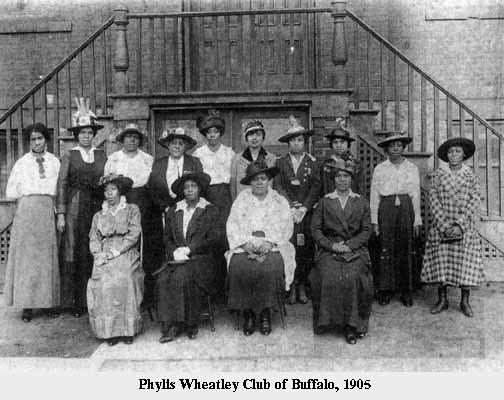Phillis Wheatley Club facts for kids
The Phillis Wheatley Clubs were special groups for African American women. They started in the late 1800s. The very first club began in Nashville, Tennessee, in 1895. These clubs helped improve communities and people's lives. Many clubs worked to end segregation and gain voting rights. The clubs were named after the famous poet, Phillis Wheatley. Some of these clubs are still active today.
Contents
What Phillis Wheatley Clubs Did
Phillis Wheatley Clubs focused on making their neighborhoods better. They also helped people in their communities. These clubs were part of a larger social reform effort.
Helping Communities and People
In New Orleans, the Phyllis Wheatley Club opened a hospital in 1896. This hospital was the only one that trained Black doctors and nurses. It was first called the Phyllis Wheatley Sanitarium and Training Hospital for Nurses.
The Chicago club started in 1896. A group of Black women, led by Elizabeth Lindsay Davis, founded it. This club created a home for young women who needed a place to stay. It was the first Black women's club in Chicago. A wealthy activist named Mary Jane Richardson Jones supported it. The first Phyllis Wheatley Home in Chicago opened in 1908. It helped Black women who moved to the city during the Great Migration. The home provided a safe place to live. It stayed open until the 1970s.
The New Orleans club, started by Sylvanie Francoz Williams, also opened a kindergarten and day care. This helped working mothers. The club also supported Black women's right to vote. In Nashville, Tennessee, the club bought a home for older women in 1925. The club in Billings, Montana, helped end segregation in that city. It also offered scholarships for young women. Some clubs, like the Phyllis Wheatley Progressive Club in Pennsylvania, even opened a night school in the late 1920s.
Promoting Education and Arts
Many clubs also encouraged learning. The Chicago club focused on Black literature. Clubs often gave books to public libraries to celebrate Black History Month. Atlanta's club helped build a reading room named after Phillis Wheatley. In Buffalo, the club celebrated 30 years since the end of slavery with a play. The club in Racine, Wisconsin, brought in artists like Maud Cuney Hare and William H. Richardson in 1921. They wanted to show off Black talent.
The Charleston, South Carolina, club hosted events with famous Black figures. These included singer Marian Anderson and writer Langston Hughes. The club in Coshocton, Ohio, also promoted Black history. They created a yearly program about important Black individuals.
How Clubs Raised Money
To pay for their charity work, the clubs held fundraisers. These events included balls, dances, theater shows, and musical receptions. In Tampa Bay, the Phyllis Wheatley Club held an annual "Defense Dance." They raised money by charging an entry fee. Sometimes, fundraising also helped other groups, like the NAACP.
Club Connections and Members
Some clubs were connected to the YWCA. Others worked on their own. The first club in Nashville joined the National Federation of Colored Women's Clubs (NFCWC) in 1897. Other clubs, like the one in Fort Worth, also joined the NFCWC.
Early club members were often professional women. Many were married to important men in their communities. However, some clubs had younger members. Other clubs included women from many different backgrounds. Many Phillis Wheatley Clubs have been active for a long time. The El Paso, Texas club celebrated its 90th anniversary in 2005.
Club Beginnings
Clubs in the 1890s
The first Phillis Wheatley Club started in Nashville, Tennessee, in 1895. Another club formed in Chicago in 1896. It focused on improving neighborhoods and helping others. Elizabeth Lindsay Davis founded it. It was one of the first groups for African American women in Chicago. Detroit's Phillis Wheatley Club began in 1897. Mame Josenberger started the club in Fort Smith, Arkansas, in 1898. She later became president of the Arkansas Association of Colored Women.
Clubs in the 1900s
The Newark, New Jersey Phillis Wheatley Club was founded in 1909. It focused on literature. Musette Brooks Gregory, a supporter of voting rights and civil rights, was one of its presidents.
Clubs in the 1910s
In Cleveland, Jane Edna Hunter started a group in 1911. It was later renamed the Phillis Wheatley Association. The El Paso, Texas Phillis Wheatley Club began in 1915. Charleston, South Carolina, started its club in 1916. It was called the Phillis Wheatley Literary and Social Club. Another club was founded in 1918 in Billings, Montana. Mattie Hambright was its first president. This Billings club continued until 1972. Dora Bell started a club in Racine, Wisconsin, in 1919. The Fort Scott, Kansas club began in 1919 to study current topics and civics.
Clubs in the 1930s
In 1932, a club in Passaic, New Jersey, worked to raise money. They wanted to create a Black community center. The Coshocton, Ohio, club started in 1933. This was just a few months before the 159th anniversary of Phillis Wheatley's book of poems. The Coshocton club was connected to the YWCA and started by Thelma Crowthers.
Important Members
- Elizabeth Lindsay Davis, who helped start the Chicago group.
- Jane Edna Hunter, who founded the Cleveland group.
- Mame Josenberger, who founded the Fort Smith, Arkansas group.
- Vivian Osborne Marsh.
- Drusilla Nixon.
- Mary Burnett Talbert, one of the founding members of the Buffalo, New York group.
- Sylvanie Francoz Williams, who founded the New Orleans club.
See also
- Phillis Wheatley
- Phyllis Wheatley YWCA
- Woman's club movement
References
Sources


